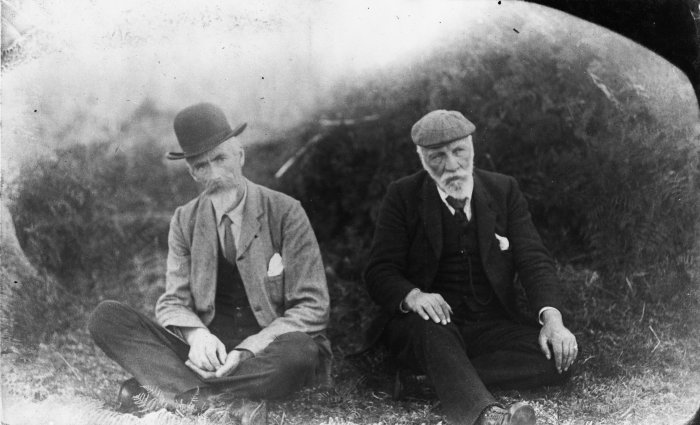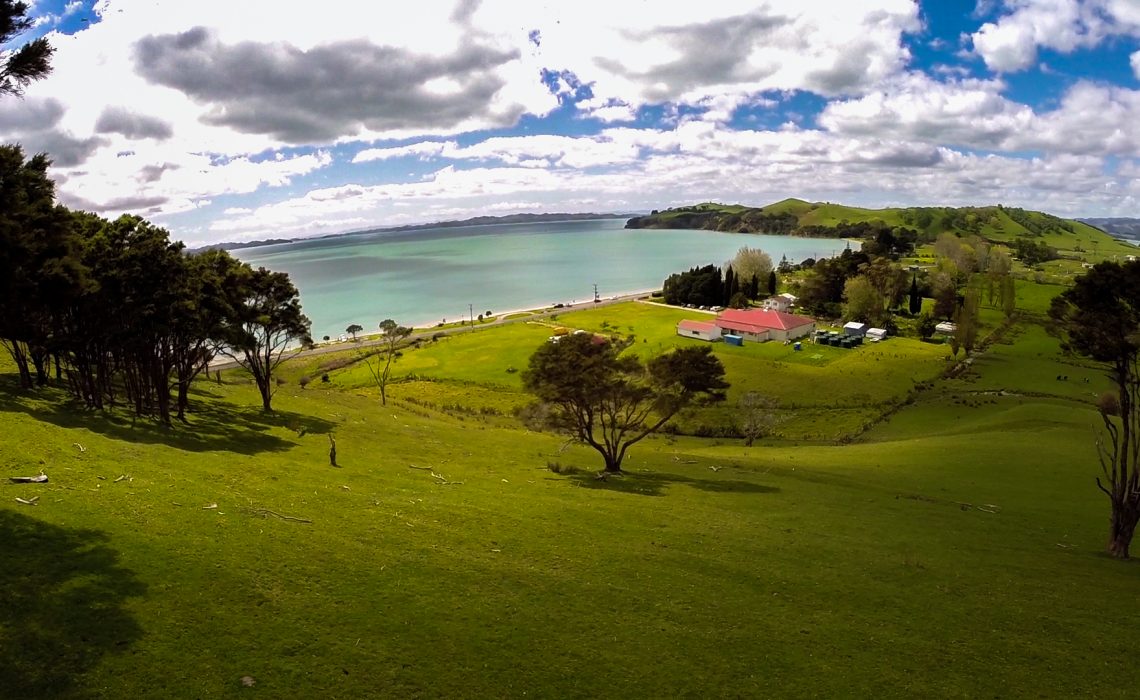|
Kiwi Tāmaki
Kiwi Tāmaki (died ) was a Māori warrior and paramount chief of the Waiohua confederation in Tāmaki Makaurau (modern-day Auckland isthmus). The third generation paramount chief of Waiohua, Kiwi Tāmaki consolidated and extended Waiohua power over Tāmaki Makaurau, making it one of the most prosperous and populated areas of Aotearoa. Kiwi Tāmaki's seat of power was at Maungakiekie / One Tree Hill, which was the most elaborate pā complex in Aotearoa. Around the year 1740, Kiwi Tāmaki angered Ngāti Whātua tribes to the north-west, by murdering guests at a funeral feast held at South Kaipara. This led the Ngāti Whātua hapū Te Taoū to wage war on Kiwi Tāmaki and the Waiohua confederation, defeating him at a battle in the lower Waitākere Ranges. Kiwi Tāmaki's death signalled the end of the Waiohua mandate in Tāmaki Makaurau, and the beginning of a permanent Ngāti Whātua presence on the isthmus. Kiwi Tāmaki's direct descendants through his son Rangimatoru became ... [...More Info...] [...Related Items...] OR: [Wikipedia] [Google] [Baidu] |
Maungakiekie
Maungakiekie / One Tree Hill is a volcanic peak and Tūpuna Maunga (ancestral mountain) in Auckland, New Zealand. It is an important place culturally and archeologically for both Māori and Pākehā. The suburb around the base of the hill is also called One Tree Hill. It is surrounded by the suburbs of Royal Oak to the west, and clockwise, Epsom, Greenlane, Oranga, and Onehunga. The summit provides views across the Auckland area, and allows visitors to see both of Auckland's harbours. The scoria cones of the hill were erupted from three craters – one is intact and two have been breached by lava flows that rafted away part of the side of the scoria cone. Lava flows went in all directions, many towards Onehunga, covering an area of , making it the second largest (in area covered) of the Auckland volcanic field, behind Rangitoto Island. The volcano erupted approximately 67,000 years ago. History Tāmaki Māori history In pre-European times, Maungakiekie / One Tree Hill ... [...More Info...] [...Related Items...] OR: [Wikipedia] [Google] [Baidu] |
Te Ākitai Waiohua
Te Ākitai Waiohua is a Māori iwi of the southern part of the Auckland Region of New Zealand. History Te Ākitai Waiohua are descended from Kiwi Tāmaki, the grandson of Huakaiwaka, himself the ancestor of the Waiohua iwi, who lived in Tāmaki (the Auckland isthmus). The name ''Te Ākitai'' commemorates Kiwi Tāmaki's uncle Huatau, who, in the early 18th century, died at sea in the Manukau Harbour and whose body was dashed up (''āki'') by the sea (''tai'') on Puketutu Island. Kiwi Tāmaki was killed in battle with Te Taoū ''hapū'' (sub-tribe) of Ngāti Whātua in the mid-18th century. Ngāti Whātua settled in Tāmaki and the Waiohua retreated to Drury, Pōkeno, Kirikiri/Papakura, Ramarama and other parts of South Auckland. In the 1780s Te Ākitai Waiohua re-established settlements at Wiri, Pūkaki and Otahuhu. Kiwi Tāmaki had a surviving son named Rangimatoru, who lived in South Auckland with Ngā Oho, a hapū of Ngāti Whātua Ōrākei formed by intermarriages betwe ... [...More Info...] [...Related Items...] OR: [Wikipedia] [Google] [Baidu] |
The Journal Of The Polynesian Society
The Polynesian Society is a non-profit organisation based at the University of Auckland, New Zealand, dedicated to the scholarly study of the history, ethnography, and mythology of Oceania. History The society was co-founded in 1892 by Percy Smith and Edward Tregear, largely in response to a conviction, widely held at the time, that the Māori and other Polynesian peoples were a dying race. Smith and his friends hoped that it would help to preserve the traditional lore of the Māori before it disappeared and provide scholars with a forum for learned discussion of their ethnographic research (Byrnes 2006). The initial membership of the society was 112, which had grown to 1,300 by 1965. Presidents have included bishops H. W. and W. L. Williams; James Pope, Edward Tregear, Percy Smith, Elsdon Best, William Skinner, Sir Āpirana Ngata, Harry Skinner, J. M. McEwen, Professor Sir Hugh Kawharu and Dame Joan Metge. The present president is Dr Richard Benton. Until her death in ... [...More Info...] [...Related Items...] OR: [Wikipedia] [Google] [Baidu] |
High Court Of New Zealand
The High Court of New Zealand ( mi, Te Kōti Matua o Aotearoa) is the superior court of New Zealand. It has general jurisdiction and responsibility, under the Senior Courts Act 2016, as well as the High Court Rules 2016, for the administration of justice throughout New Zealand. There are 18 High Court locations throughout New Zealand, plus one stand-alone registry. The High Court was established in 1841. It was originally called the "Supreme Court of New Zealand", but the name was changed in 1980 to make way for the naming of an eventual new Supreme Court of New Zealand. The High Court is a court of first instance for serious criminal cases such as homicide, civil claims exceeding $350,000 and certain other civil cases. In its appellate function, the High Court hears appeals from the District Court, other lower courts and various tribunals. Composition and locations The High Court comprises the Chief Justice (who is head of the judiciary) and up to 55 other Judges (which ... [...More Info...] [...Related Items...] OR: [Wikipedia] [Google] [Baidu] |
Ngā Oho
Ngā Oho, also known as Ngā Ohomatakamokamo-o-Ohomairangi, is the name of a historical iwi (tribe) of Māori who settled in the Auckland Region. In the 17th century, Ngā Oho and two other tribes of shared heritage, Ngā Riki and Ngā Iwi, formed the Waiohua confederation of tribes. History The name Ngā Oho was one of the earlier tribal names used by Tāmaki Māori people, descended from the legendary ''Tainui'' tohunga/navigator Rakatāura (also known as Hape), and ''Te Arawa''. Ngā Oho was a name that was used as a unifying name for Tainui peoples in Tāmaki Makaurau. By the 14th century, Ngā Oho had settled in the Waitākere Ranges area. Ngā Oho's rohe once spanned from Cape Rodney/Okakari Point near Leigh to Tauranga. The iwi is named either after the historical rangatira Ohomairangi or Ohomatakamokamo. Ohomatakamokamo was an ariki who lived at Rarotonga / Mount Smart, conquering the Tāmaki Makaurau area. Ohomatakamokamo's descendants settled on the Tāmaki isthm ... [...More Info...] [...Related Items...] OR: [Wikipedia] [Google] [Baidu] |
Ngāi Tai Ki Tāmaki
Ngāi Tai ki Tāmaki is a Māori tribe that is based in the area around Clevedon, part of the Auckland region (''Tāmaki'' in the Māori language). It is one of the twelve members of the Hauraki Collective of tribes. The founding ancestors of Ngāi Tai ki Tāmaki came to New Zealand in the ''Tainui'' migration canoe and left it when it was dragged across Te Tō Waka, the portage from the Tāmaki River to the Manukau Harbour. Their descendants occupied parts of the Hauraki Gulf, including east Auckland as far inland as Otara and Maungarei, as well as Clevedon, Maraetai and Howick. Te Irirangi Drive, a major highway in Manukau City, is named after one of their ''rangatira'' (chiefs), Tara Te Irirangi. Ngāi Tai has a marae at Umupuia Beach, between Maraetai and Clevedon. They also use the Ngāti Tamaoho marae at Karaka. In 2015 the Crown settled with Ngāi Tai ki Tāmaki over historic grievances, including both financial and cultural compensation. See also *List of iw ... [...More Info...] [...Related Items...] OR: [Wikipedia] [Google] [Baidu] |
Ngāti Te Ata
Iwi () are the largest social units in New Zealand Māori society. In Māori roughly means "people" or "nation", and is often translated as "tribe", or "a confederation of tribes". The word is both singular and plural in the Māori language, and is typically pluralised as such in English. groups trace their ancestry to the original Polynesian migrants who, according to tradition, arrived from Hawaiki. Some cluster into larger groupings that are based on (genealogical tradition) and known as (literally "canoes", with reference to the original migration voyages). These super-groupings generally serve symbolic rather than practical functions. In pre-European times, most Māori were allied to relatively small groups in the form of ("sub-tribes") and ("family"). Each contains a number of ; among the of the Ngāti Whātua iwi, for example, are Te Uri-o-Hau, Te Roroa, Te Taoū, and Ngāti Whātua-o-Ōrākei. Māori use the word ''rohe'' to describe the territory or bounda ... [...More Info...] [...Related Items...] OR: [Wikipedia] [Google] [Baidu] |
Tāmaki Māori
Tāmaki Māori are Māori ''iwi'' and ''hapū'' (tribes and sub-tribes) who have a strong connection to Tāmaki Makaurau (the Auckland Region), and whose rohe was traditionally within the region. Among Ngā Mana Whenua o Tāmaki Makaurau (the Māori tribes of Auckland), also known as the Tāmaki Collective, there are thirteen iwi and hapū, organised into three rōpū (collectives), however Tāmaki Māori can also refer to subtribes and historical iwi not included in this list. Ngāti Whātua Rōpū Ngāti Whātua descend from the '' Māhuhu-ki-te-rangi'' waka, which landed north of the Kaipara Harbour. The rōpū includes Ngāti Whātua o Kaipara, Ngāti Whātua Ōrākei and Te Rūnanga o Ngāti Whātua. Te Rūnanga o Ngāti Whātua is a Māori Trust Board formed in the mid 2000s to represent the interests of Ngāti Whātua iwi and hapū collectively, including those outside of Ngāti Whātua o Kaipara and Ngāti Whātua Ōrākei. The rūnanga represents Ngā Oho, Ngāi Tāh ... [...More Info...] [...Related Items...] OR: [Wikipedia] [Google] [Baidu] |
Paora Tūhaere
Paora Tūhaere ( 1825 – 12 March 1892) was a leader of the Ngāti Whātua Māori iwi (tribe) of Auckland, New Zealand, in the 18th century. His mother was Atareta Tuha, the sister of Ngāti Whātua leader Apihai Te Kawau, and his father was Whanararei, from Te Taoū hapū of Ngāti Whātua. He became the acknowledged leader of the iwi when Te Kawau died in 1869. Tūhaere was born at Hikurangi near Piha on the west coast of the Waitākere Ranges The Waitākere Ranges is a mountain range in New Zealand. Located in West Auckland between metropolitan Auckland and the Tasman Sea, the ranges and its foothills and coasts comprise some of public and private land. The area, traditionally kno ..., during the time of the Musket Wars, when Ngāti Whātua took refuge in the ranges and the Waikato Region. References 1892 deaths Ngāti Whātua people Year of birth unknown 1825 births Te Taoū people People from the Auckland Region {{Māori-bio-stub ... [...More Info...] [...Related Items...] OR: [Wikipedia] [Google] [Baidu] |
Waitematā Harbour
Waitematā Harbour is the main access by sea to Auckland, New Zealand. For this reason it is often referred to as Auckland Harbour, despite the fact that it is one of two harbours adjoining the city. The harbour forms the northern and eastern coasts of the Auckland isthmus and is crossed by the Auckland Harbour Bridge. It is matched on the southern side of the city by the shallower waters of the Manukau Harbour. With an area of , it connects the city's main port and the Auckland waterfront to the Hauraki Gulf and the Pacific Ocean. It is sheltered from Pacific storms by Auckland's North Shore, Rangitoto Island, and Waiheke Island. Etymology The oldest Māori name of the harbour was Te Whanga-nui o Toi (The Big Bay of Toi), named after Toi, an early Māori explorer. The name ''Waitematā'' means "Te Mata Waters", which according to some traditions refers to a mauri stone (a stone of Māori religious significance) called Te Mata, which was placed on Boat Rock (in the ... [...More Info...] [...Related Items...] OR: [Wikipedia] [Google] [Baidu] |
_(cropped).jpg)


.jpg)